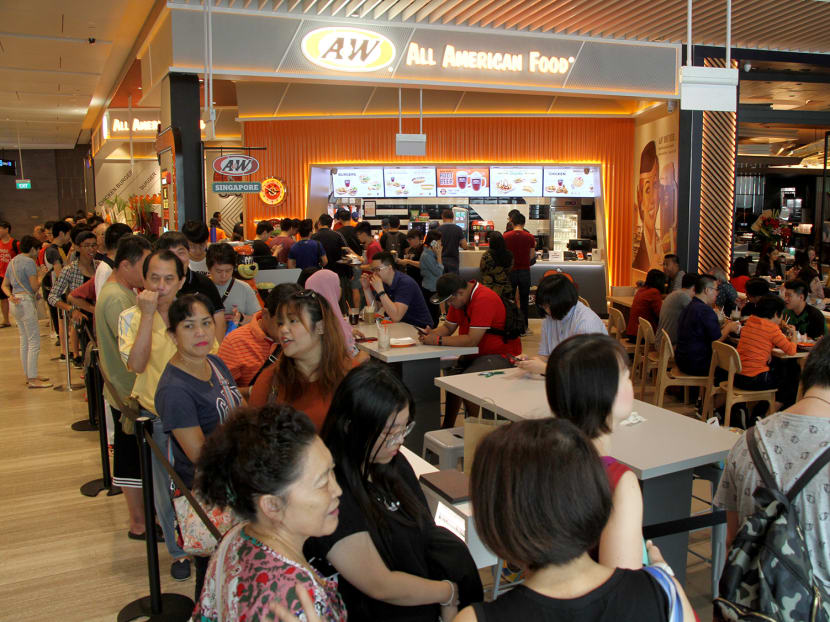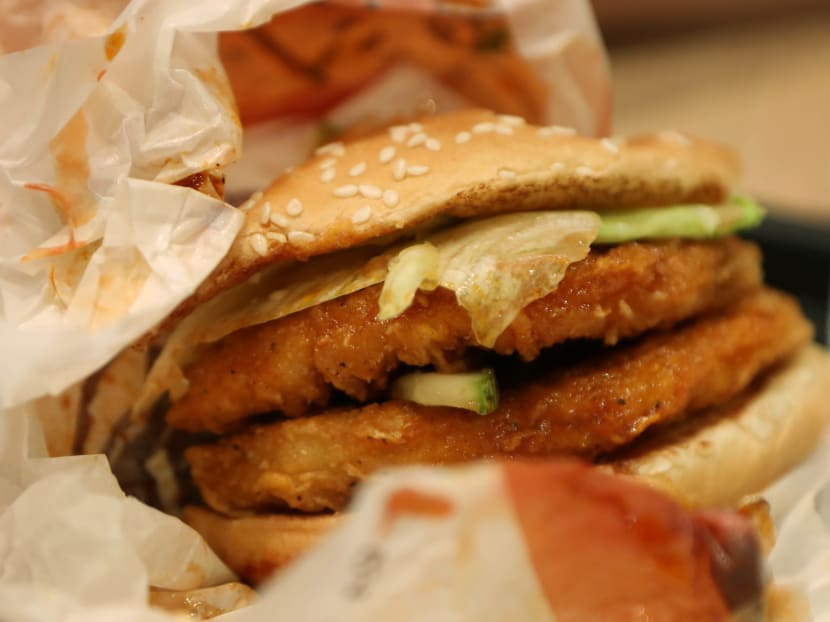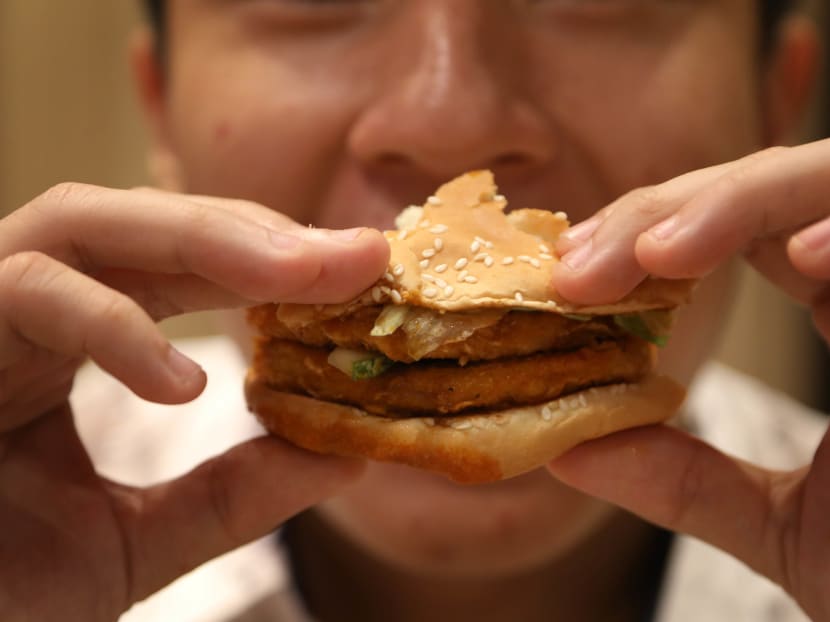The Big Read: Through thick and thin (waistlines) — S’poreans’ enduring love affair with fast food
SINGAPORE — When American burger joint Shake Shack opened its doors at Jewel Changi Airport in April, Mr Watt Zhong Qing, 29, was one of the first in line.
SINGAPORE — When American burger joint Shake Shack opened its doors at Jewel Changi Airport in April, Mr Watt Zhong Qing, 29, was one of the first in line.
The part-time service staff eats fast food about four times a week.
He told TODAY that back in 2013, when Filipino fast food chain Jollibee first arrived here, he queued 3.5 hours just for a taste of it.
“(It) was worth it,” said the food enthusiast, whose affinity with fast food started when he was 10 and his aunt bought him McDonald’s Happy Meal, which came with a toy.

These days, long queues could still be spotted whenever new fast food players came to town, as seen recently with the opening of Shake Shack and A&W at Jewel Changi Airport.
New flavours introduced by the fast food chains also tend to generate much buzz, with offerings sometimes sold out in just weeks, such as McDonald’s Nasi Lemak Burger.
And sometimes, it is not just the food: The McDonald’s Hello Kitty craze back in 2000 saw thousands of Singaporeans spending hours in line for the sake of getting special mementos issued by the fast food giant. Around 2.8 million toys were sold within 40 days, said the National Library Board’s (NLB) web encyclopedia.
Based on latest figures from the Department of Statistics (SingStat), fast food outlets in Singapore generated a total of about S$1.1 billion in operating receipts in 2016.
.embed-container { position: relative; padding-bottom: 56.25%; height: 0; overflow: hidden; max-width: 100%; } .embed-container iframe, .embed-container object, .embed-container embed { position: absolute; top: 0; left: 0; width: 100%; height: 100%; }Singaporeans’ seemingly insatiable appetite for burgers, fries and the like has helped the fast food sector buck the overall trend in the food and beverage (F&B) industry, which saw a 10 per cent decline in sales from 2000 to 2018.
Over the same period, sales from fast food outlets grew 29 per cent, based on SingStat data. In contrast, sales at restaurants declined 20 per cent, while those at other eating places — such as cafes — fell by 13 per cent.
The situation in Singapore stands in contrast with the United States — the country of origin for many global fast food chains that households around the world have come to know.
According to media reports, American millennials are shunning these chains while an oversaturated market and rising labour costs are eating into the profitability of these companies. Other factors include rising health consciousness and competition from neighbourhood eateries serving the same fare, said experts.
However, in Singapore, despite greater national awareness of the need to eat healthily, many just cannot stay away from their fast food fix.
Take Mr Muhammad Hafiz for example. The self-described health conscious individual runs and does other exercises about three times a week.
But that has not stopped the 30-year-old management consultant from indulging in his guilty pleasure of fast food at least once or twice weekly.
His “soft spot” for fast food started while growing up, when he and his friends would frequent fast food chains after a game of football or rugby.
Likewise, football enthusiast Lance Ling, 32, gives in to his “fried-food craving” nearly three times a week.
“It’s a convenience thing, really. Even now, McDonald’s is just downstairs (from his home) and it is easy to (buy takeaways),” said Mr Ling, who works in the shipping industry and recently moved to Buangkok with his spouse.

HUGE APPETITE FOR FAST FOOD
Fast food chains are generally defined as those which sell mass-produced items, such as burgers and fried food, and serve them quick.
Singapore’s love for fast food began in 1968, when the first A&W restaurant opened its doors in the former Malaysia-Singapore Airlines building at Robinson Road. Next came Colonel Sanders in 1976 and then Ronald McDonald in 1979, with its first store at Liat Towers in Orchard. Burger King arrived in 1982.
A sign of things to come, the number of customers who attended the McDonald’s opening was so large that a world record was set then for serving the highest volume of hamburgers in a single day, according to the NLB’s web encyclopedia.
The record was only broken in the 1990s when McDonald’s opened in Beijing, China.
Over the past decades, the major fast food chains have grown expanded rapidly in Singapore.
For example, there are now 135 McDonald’s outlets and 86 KFC joints scattered across the island. Burger King will be opening its 50th outlet in Singapore in July, its spokesperson said.
Another household name, Long John Silver’s, first opened in Singapore in 1983.
Between 2016 and 2018, it expanded from 19 to 26 outlets here, with sales going up in tandem by about 30 per cent, said its spokesperson.
Many other international brands have also entered the Singapore market, including Pizza Hut, Popeyes, Carl’s Junior and Texas Chicken.
But it is not all smooth sailing: Brands such as Milano’s Pizza, Hardee’s, Wendy’s and Taco Bell had found the going tough and exited the Singapore market.
A&W also suffered the same fate — closing down its five remaining outlets at that time in 2003 — before returning to the Republic to much fanfare.
A&W international business development manager Sally See said that going forward, the chain would be opening new outlets at a “comfortable pace”.
“We want to ensure that we have outlets running well and optimally before expanding further,” she said.
Based on data from market research firm Euromonitor International, McDonald’s had the largest market share (40 per cent) in Singapore last year — way ahead of its closest rival, KFC (13 per cent). In its report, the firm included convenience store chain 7-eleven, which came in joint-third with Subway, with both having 6 per cent of the market share, Next was Burger King (4 per cent), followed by Pizza Hut (3 per cent). The Soup Spoon, Pasta Mania and Long John Silver’s each has a market share of about 2 per cent.
RECIPE FOR SUCCESS
Experts say that fast-food chains do particularly well in Singapore because of several reasons. These include the fact that the healthy eating movement here is not as prevalent as in the United States and other countries in Europe, and an English-speaking population who is exposed to international cultures.
In Singapore, fast food is not much more expensive compared with local fare such as hawker food, the experts noted.
Mr Karthik Bakthavathsalem, an F&B lecturer at Nanyang Polytechnic, said that in countries such as Malaysia and Indonesia, local food options are much cheaper than fast food. There are also local fast-food chains in these countries, such as Jollibee in the Philippines, that prevent the global ones from garnering too much market share, said Mr Lucas Tok, marketing lecturer at Singapore Polytechnic.
Given Singaporeans’ “higher level of awareness backed with purchasing power”, Adjunct Associate Professor Lynda Wee of Nanyang Business School said the Republic makes an “excellent” test bed for fast-food outlets to expand or try out new products.
Long John Silver’s, for example, does exactly that.
Catering to Singaporeans’ taste buds and preferences help in its preparations for overseas expansion, its spokesperson said.
“Being a multi-racial country with a variety of religions, Singapore is a food capital with a diverse range of cuisines available despite its small land mass,” the spokesperson added.
The culture of dining out among Singaporeans could also be a contributing factor, said Dr Guan Chong, a marketing professor at the Singapore University of Social Sciences.
According to a 2018 Nielsen survey, 55 per cent of Singaporeans ate out on a weekly basis, up from 51 per cent in 2015.
In the US, only about 33 per cent dined out, noted Dr Guan. The Nielsen survey conducted in Singapore also found that 76 per cent preferred to patronise fast-food outlets, up from 66 per cent three years ago.
The experts said the convenience of fast food is a major attraction for Singapore customers as it fits into their busy lifestyle. Apart from relative affordability and speed of service, fast food outlets are strategically located to tap on a large catchment of potential customers.
McDonald’s is especially “aggressive” when it comes to location strategy, said Mr Samuel Tan, course manager of Temasek Polytechnic’s diploma in retail management.
The market leader has a comprehensive team to select the best site for new outlets, he noted.

For the Nielsen survey, respondents cited convenience or accessibility (58 per cent), food taste (50 per cent) and low price or value-for-money (48 per cent) as the top reasons for buying from fast food outlets, said Nielsen’s executive director for consumer insights Garick Kea.
“Close-to-home proximity is also important for time-strapped consumers. So far the uptake of these convenience options has been strongest in mature markets, and Singapore being a developed market is seeing this growth,” said Mr Kea.
In contrast, restaurants are located only in certain places. “So the economies of scale are not there,” said Mr Karthik.
A fast-food chain’s assembly line model gives it an advantage over restaurants. This helps to lower operational costs and improve efficiency, without the need to hire skilled chefs for food preparation, said Dr Guan.
Successful and targeted marketing has also helped enhance fast food’s appeal.
F&B consultant and branding specialist Derrick Chew said: “(McDonald’s) Happy Meal is one example. The culture already ingrained is that McDonald’s is a part of your life… It’s nostalgic to a lot of Singaporeans growing up in that period.”
In making a comeback to Singapore, A&W believes that its brand “holds a special place in the hearts of many in Singapore, who now associate visits to A&W with very fond childhood memories,” said Ms See.
STAYING NIMBLE IN A CUT-THROAT INDUSTRY
While every fast food business wants a slice of the pie, being able to sustain growth is no piece of cake.
Stiff competition has led to the failure of many global brands trying to establish themselves in Singapore.
It was the main reason that led A&W, despite having a first-mover advantage here, to exit in 2003, the experts noted.
With competitors marketing their offerings much better than A&W, the chain faded into obscurity, said Mr Tok.
“With fast food, the main factor is convenience. If you’re going to be obscure and don't market yourself, you forget to remind people that you’re there and convenient to get to,” he added.
While several fast food chains have thrived in Singapore, it will not be easy for new entrants — or in A&W’s case, those seeking to make a comeback — to gain a foothold.

“The big players are well grounded and they have already saturated our tiny island-state with many outlets and build their loyal customers. The dominant market share strategy of the fast-food industry is somewhat a barrier and threatening to new entries,” said Mr Tan of Temasek Polytechnic.
The need for fast food chains to be accessible also means that new players need resources to scale up fast and spread the set-up and operation costs, said Adjunct Associate Professor Wee.
But they usually lack the resources and capital to sustain themselves in a highly competitive market, Mr Tan noted.
Some fast-food chains have tried to cut costs using technology. For example, the introduction of self-service kiosks reduces the reliance on manpower, while working with food delivery applications helps a chain maintain its market presence.
Getting on food delivery platforms have helped Texas Chicken reach more customers, said Mr Eugene Lim, marketing director of Select Group that runs Texas Chicken in Singapore.
However, the use of delivery apps would eventually change customer behaviours, he noted. “In the long run, there will be impact (on fast food chains) if all customers opt to stay at home and order in. In fact, it is already (starting to happen) now,” said Mr Lim.
Ultimately, it is the service and menu offerings that matter, the experts said.
McDonald’s fresh and new menu offerings, as well as its ability to maintain its service level to generate higher customer satisfaction than other players, have helped the fast food giant to become a clear market leader, Mr Tan noted.
Despite facing high operating costs, manpower shortage and customers’ fast-changing tastebuds, fast food chains here have generally been adaptive and responsive to change — especially those that have thrived, the experts said.
It is not just about giving local flavours a twist such as Burger King’s Hainanese Tendergrill Chicken Burgers, or McDonald’s Durian McFlurry or KFC’s Mala Chicken.
Fast food chains here have introduced new food items in line with the latest trending flavours, such as McDonalds’ Salted Egg Fries or KFC’s Korean-inspired Yang Yeum Chicken.
There have also been tie-ups with other international brands, such as McDonald’s Hello Kitty toys, or global events, such as KFC’s Ronaldo Feast during the 2014 World Cup.
Fast food chains have periodically refreshed the look and feel of their outlets as well.
In addition to self-service kiosks and online food delivery service, investments in automatic cooking machinery in the kitchen, have helped fast food chains to cut down costs.
To cater to an increasingly health conscious population, fast food chains have also rolled out healthier options on their menus.

HEALTH CONCERNS
Despite such efforts, fast food is still high in sodium, fats, cholesterol and calories — all known to contribute to health problems such as obesity, diabetes, and cardiovascular diseases.
In 2004, the release of a documentary, “Super Size Me”, triggered a backlash against the fast food industry in the US.
It featured filmmaker Morgan Spurlock who ate McDonald’s food for 30 consecutive days, and gained 11kg as a result.
Mindful of the adverse health impact of fast food consumption, authorities around the world have taken steps to curtail the marketing and advertising of such food to young children.
In the United Kingdom, Youtube ads by brands such as McDonald’s and KFC were recently banned by an advertising watchdog for targeting children under 16.
This followed bans on junk food advertisements in London’s transport networks earlier this year.
Australian state Queensland has also banned junk food advertisements starting this year, with plans to phase out such advertisements over time.
In Singapore, the authorities introduced in 2015 a set of advertising guidelines where F&B outlets, including fast food chains, are not allowed to advertise unhealthy products — such as sugar-based products and soft drinks — to children under 13.
Like other affluent societies, Singapore is not spared from rising obesity rates among the young.
In 2017, 13 per cent of children in Singapore’s mainstream schools were found to be overweight, up from 11 per cent in 2011, said Senior Minister of State for Health Amy Khor last year.
So far, the fast food industry in Singapore has been spared from any consumer backlash stemming from health concerns — even after the “Super Size Me” documentary gained international prominence.
Mr Karthik, the lecturer at Nanyang Polytechnic, believes that the film’s impact on the fast food industry in other countries would have been bigger today, in the age of social media.
Other experts noted that unlike in the US, fast food is not a staple in Singapore.
Still, the documentary had persuaded some Singaporeans to be more mindful of the food they ate, and spurred fast food chains here to offer healthier options, the experts said.
Fast food fans in Singapore played down the health concerns, reiterating that it was fine as they eat it in moderation and their diet is balanced.
Mr Hafiz, for example, said he avoids eating fried food at home, opting for grilled or roasted meat instead.
Mr Ling added: “I think it’s okay if you don’t eat it every day… just need to have a mixed diet for your other meals.”
While fast food joints here provide healthier alternatives, nutritionists said it is unclear how effective they are in encouraging consumers to eat more healthily.
To begin with, people who go to fast food outlets are not looking to eat healthily, said consultant dietician and nutritionist Dr Naras Lapsys.
While the nutritional value of these healthier options is not negated just because it is prepared at a fast food outlet, the sauces added into these food items might defeat its purpose.
“Sauces (which fast-food joints) put in might still be high in sugar. (There) might be additional things in the meal that are not that great, (the) chicken still happens to be fried and battered,” said Dr Lapsys.
Another nutritionist, Ms Gladys Wong, warned that seemingly healthier options might not necessarily be so. “Salads may not be necessarily healthy, depending on the salad dressing that the customer chooses to drown the salad with,” she said.
“Steamed corn may be laced with butter or margarine and salt, thus (it can be) high in fats and sodium.”

FOOD FOR THOUGHT
Going forward, the experts believe that the fast food industry here will continue to thrive.
However, it may usher in the rise of what has been called “fast casual” outlets.
An intermediate concept between fast food and casual dining, fast casual eatery chains have taken off in the US, including the likes of Shake Shack and Chipotle.
These chains market themselves as offering the same quick and convenient service which consumers can get at fast food chains, but with better ingredients at slightly higher prices.
While fast casual outlets have yet to establish themselves in Singapore, fast food chains here may have to contend with them in the future, said Mr Karthik.
In the meantime, some are concerned that the enduring popularity of fast food among Singaporeans could come at the expense of homegrown hawkers and food culture.
Nevertheless, food blogger Leslie Tay felt that hawkers can learn from the fast food model, such as mass producing food of a consistent quality within a short time.
Hawkers currently “don’t quite have the know-how” yet, said Dr Tay, 50, who runs a popular food blog ieatishootipost.sg.
While he believes that people of his generation would stay true to hawker food, he was not so sure about the younger generation.
“(Fast food is) comfort food. It’s easy, cheap and tasty, and customers can dine in air-conditioned facilities,” said Dr Tay.
“Air-con is very important,” he quipped.
Food critic and consultant K F Seetoh, who founded the Makansutra website, noted that the younger generation grew up inundated by the marketing efforts of fast-food giants.
“Fast-food outlets are winning, but they have not taken over (local food) — not yet,” he said.












